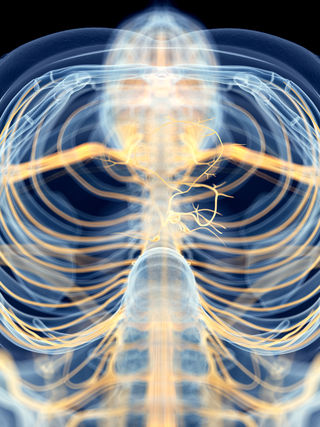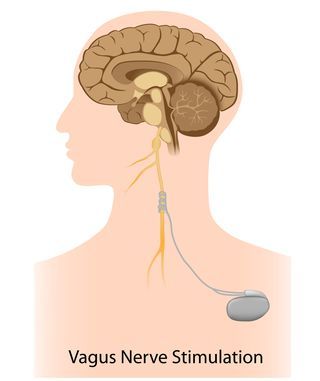Vagus Nerve
Vagus Nerve Stimulation Enhances Brain Plasticity
The new treatment may help restore function to stroke victims.
Posted May 16, 2018

Vagus nerve stimulation (VNS) enhances targeted neuroplasticity, helping the brain build stronger neural connections after a stroke, according to pioneering research from the University of Texas at Dallas. Using an animal model, the researchers have demonstrated for the first time that pairing VNS with a physical therapy task accelerates the recovery of motor skills.
The researchers published their findings, “Vagus Nerve Stimulation Enhances Stable Plasticity and Generalization of Stroke Recovery,” in the journal Stroke. A human clinical trial of the same treatment, "Pivotal Study of VNS During Rehab After Stroke (VNS-REHAB)," is currently underway at 18 research sites across the US and in the UK. The goal of the study is to gauge the efficacy of paired vagus nerve stimulation in helping stroke patients recover motor skills more quickly.
What Is Vagus Nerve Stimulation?

Vagus nerve stimulation is delivered via a small, surgically implanted device that uses electrical impulses of varying intensities and pulse-widths to activate the vagus nerve. Electrical stimulation of the vagus nerve using VNS is an FDA-approved treatment for drug-resistant epilepsy and treatment-resistant depression. A recent proof-of-concept human study also found that VNS is a viable treatment for inflammatory joint diseases such as rheumatoid arthritis.
The sudden loss of blood flow after a stroke causes neurons in any stroke-affected brain region to die, which cuts off connections to other nerve cells. The loss of motor skills in an arm or leg after a stroke is caused by a loss of connectivity between nerve cells in the limb with corresponding motor regions of the brain.
Using an animal model, the UT Dallas researchers found that brief bursts of VNS strengthen communication pathways by building stronger cell connections in the brain after a stroke. In fact, their results show that coupling VNS with targeted movement therapies dramatically boosts the benefit of rehabilitative training after a stroke. And, in animal studies, these improvements lasted for months after the completion of VNS targeted therapy.
As the authors of this study, led by Eric C. Meyers, explain: "This study provides the first evidence that VNS paired with rehabilitative training after stroke (1) doubles long-lasting recovery on a complex task involving forelimb supination, (2) doubles recovery on a simple motor task that was not paired with VNS, and (3) enhances structural plasticity in motor networks."
Michael Kilgard, associate director of the Texas Biomedical Device Center and professor of neuroscience in the School of Behavioral and Brain Sciences at UT Dallas, was a senior co-author of this research. Kilgard is the principal investigator at the UTD Cortical Plasticity Laboratory. His team also includes Seth Hays, a postdoctoral researcher in the School of Behavioral and Brain Sciences at UT Dallas, who specializes in targeted plasticity therapy to alleviate motor dysfunction.
"Our experiment was designed to ask this new question: After a stroke, do you have to rehabilitate every single action?" Kilgard said in a statement. "If VNS helps you, is it only helping with the exact motion or function you paired with stimulation? What we found was that it also improves similar motor skills as well, and that those results were sustained months beyond the completion of VNS-paired therapy."
The UT Dallas researchers are optimistic that their latest research on targeted vagus nerve stimulation is a pivotal step toward creating guidelines for standardized usage of VNS during post-stroke therapy in humans. "We have long hypothesized that VNS is making new connections in the brain, but nothing was known for sure," Hays said in a statement. "This is the first evidence that we are driving changes in the brain in animals after brain injury. It's a big step forward in understanding how the therapy works — this reorganization that we predicted would underlie the benefits of VNS."
Another recent study from UT Dallas found that moderate intensity vagus nerve stimulation optimized the neuroplasticity-enhancing and memory-enhancing effects of VNS more effectively than low or high-intensity stimulation. Notably, the researchers pinpointed that the optimal pulse width and current intensity were marked by an “inverted-U” pattern in which too much or too little VNS was less effective than a 'Goldilocks' sweet spot of moderate intensity that was just right. These 2017 findings were published in the journal Brain Stimulation.
Paired Vagus Nerve Stimulation Offers New Hope for Stroke Rehabilitation
In 2017, the makers of a vagus nerve stimulation device launched a randomized, double-blind clinical trial of VNS rehab for patients after a cerebrovascular stroke. This study, currently underway, will include up to 120 subjects at 18 clinical locations across the US and in the UK. The estimated conclusion date of preliminary research for this clinical trial is June 30, 2019.
The Ohio State University is one of the institutions participating in the paired VNS clinical trial. Marcie Bockbrader of the Wexner Medical Center at OSU is their principal investigator for the trial.
In a recent press release, Bockbrader said: “This nerve stimulation is like turning on a switch, making the patient’s brain more receptive to therapy. The goal is to see if we can improve motor recovery in people who have what is, in effect, a brain pacemaker implanted in their body. The idea is to combine this brain pacing with normal rehab, and see if patients who’ve been through all of their other usual therapies after a stroke can get even better.”
Below is a YouTube video of Marcie Bockbrader and colleagues in their paired VNS therapy lab along with a patient describing his stroke rehab process:
For this clinical trial, each study participant receives three one-hour sessions of intensive physiotherapy per week for a total of six weeks. The goal is to improve task-specific motor arm function. Half of the group participating in this clinical trial had a vagus nerve stimulation device surgically implanted; the other half will serve as a control group.
During each rehabilitation therapy session, whenever a patient correctly performs a particular motor skill, the therapist pushes a button to trigger an optimal pulse width and current intensity of vagus nerve stimulation. The hypothesis is that if precise and accurate movements are positively reinforced by a brief burst of VNS during a trial-and-error learning process that these actions become “hardwired" into the brain more quickly.
“We are trying to see if this neurostimulator could be used to boost the effective therapy, creating a sort of ‘supercharged therapy.’ We want to determine if patients can recover more quickly through the use of this stimulation,” Bockbrader concluded.
References
Eric C. Meyers, Bleyda R. Solorzano, Justin James, Patrick D. Ganzer, Elaine S. Lai, Robert L. Rennaker, Michael P. Kilgard, Seth A. Hays. “Vagus Nerve Stimulation Enhances Stable Plasticity and Generalization of Stroke Recovery.” Stroke (First published online: January 25, 2018) DOI: 10.1161/STROKEAHA.117.019202
Kristofer W. Loerwald, Michael S. Borland, Robert L. Rennaker II, Seth A. Hays, Michael P. Kilgard. "The Interaction of Pulse Width and Current Intensity on the Extent of Cortical Plasticity Evoked by Vagus Nerve Stimulation." Brain Stimulation (First published online: November 15, 2017) DOI: 10.1016/j.brs.2017.11.007




